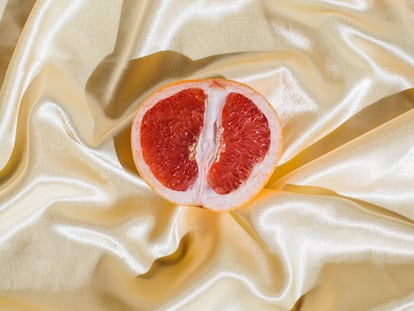What is the safest way to clean your ears properly?
One of the most frequent problems health centres find when removing wax plugs is due to the misuse of swabs

We can clean our ears in many ways. The first thing to bear in mind is that wax is produced by glands in the ear canal. The substance acts like a broom that moves outward, and along the way it collects the dead skin and microscopic particles from inside the ear. We make the wax’s outward journey easier through moving our jaw when we speak and chew. And what is important to remember is that the wax is there to protect our ears.
So, having wax is not bad. In fact, it is natural. There are people who produce much more wax than others, and that has nothing to do with hygiene. It is intrinsic to the person. In the same way, there are people whose earwax does not lead to plugs and others for whom the opposite is true. It all depends on our skin type. The problem can occur if there is a lot of wax or if we push it deeper and deeper into the ear when trying to clean it. In both situations a wax plug might build up.
That is why it is important to know how to clean your ears properly. You can use different things, like the corner of a towel, a baby wipe, or a cotton swab, but never insert anything into the external auditory canal. There are no bad products if they are used correctly. In ENT medicine, we do not recommend the use of swabs, syringes that use pressurized water, or seawater sprays because misusing them causes the wax to be impacted more deeply. These treatments can cause wounds to the skin in the canal and even the ear drum itself, and they can also lead to external ear infections. We have to insist that hygiene begins with cleaning the folds of the pinna (ear) and that you only have to clean the meatus or entrance to the external auditory canal. Do not put anything inside.
As mentioned above, it is the people who generate the most wax who may have the most problems with plugs and who should be most careful when cleaning their ears. For these people there are different products that help with ear hygiene, but there are some things that they should know about them.
Swabs themselves are not dangerous, unless they push back in what is naturally trying to come out. If wax accumulates, in the end it can create an impacted plug in the canal that can cause us to feel pain or pressure in the ear, or even decrease our ability to hear. There are some spray products and syringes to use with water, which are intended to flood the ear canal with liquid and thus drag the plug out. But if the patient has not been trained how to do it properly, or they do it wrong, they can also push the plug farther in and cause the same problems as with the cotton swabs. Besides that, retained water can lead to infections and it is even more dangerous for patients who have a perforated ear drum. That is why we would advise you not to use any of these remedies if you are not a health professional.
The most useful home remedies are drops that act as wax solvents, or oils that degrade the wax little by little and prevent plugs from forming. Patients should use these oils periodically, depending on how quickly the wax forms plugs.
All in all, it is important to repeat that absolutely nothing whatsoever should be inserted into the ear canal. One of the most frequent problems health centers find when removing wax plugs is due to patients misusing swabs, which end up causing the wax to accumulate inside the ear, making it difficult to remove.
Elisa Gil-Carcedo is an ENT physician at the Río Hortega University Hospital in Valladolid and an associate professor at the Faculty of Medicine of the University of Valladolid.
Sign up for our weekly newsletter to get more English-language news coverage from EL PAÍS USA Edition
Tu suscripción se está usando en otro dispositivo
¿Quieres añadir otro usuario a tu suscripción?
Si continúas leyendo en este dispositivo, no se podrá leer en el otro.
FlechaTu suscripción se está usando en otro dispositivo y solo puedes acceder a EL PAÍS desde un dispositivo a la vez.
Si quieres compartir tu cuenta, cambia tu suscripción a la modalidad Premium, así podrás añadir otro usuario. Cada uno accederá con su propia cuenta de email, lo que os permitirá personalizar vuestra experiencia en EL PAÍS.
¿Tienes una suscripción de empresa? Accede aquí para contratar más cuentas.
En el caso de no saber quién está usando tu cuenta, te recomendamos cambiar tu contraseña aquí.
Si decides continuar compartiendo tu cuenta, este mensaje se mostrará en tu dispositivo y en el de la otra persona que está usando tu cuenta de forma indefinida, afectando a tu experiencia de lectura. Puedes consultar aquí los términos y condiciones de la suscripción digital.
More information
Últimas noticias
‘How does it feel to be a failure?’: Elizabeth Berkley’s journey from ‘Showgirls’ ridicule to vindication
The story of the Málaga virus: The code that haunted Google’s cybersecurity center director for 30 years
The impact of Ecuador’s mega-prison: A polluted river, cleared forests and military checkpoints
Corinne Low: ‘I’m more concerned about the female happiness gap than the gender wage gap’
Most viewed
- The low-cost creative revolution: How technology is making art accessible to everyone
- Christian Louboutin: ‘Young people don’t want to be like their parents. And if their parents wear sneakers, they’re going to look for something else’
- All the effects of gentrification in one corner of Mexico’s Colonia Roma
- Liset Menéndez de la Prida, neuroscientist: ‘It’s not normal to constantly seek pleasure; it’s important to be bored, to be calm’
- December Social Security and SSI payments: Dates, double checks and the 2026 COLA increase










































